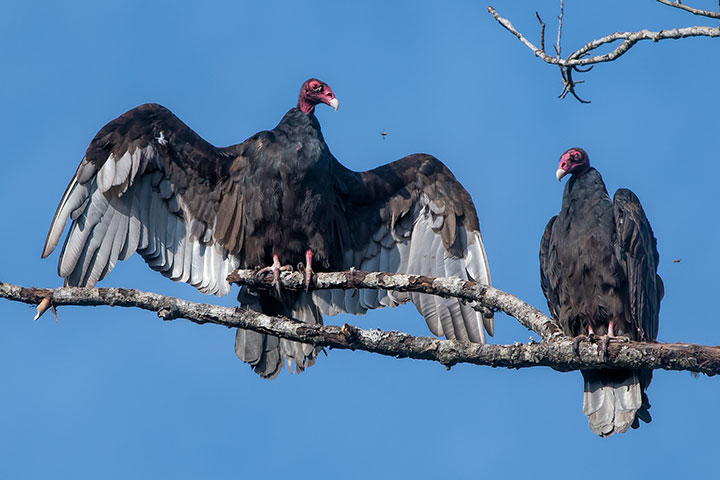Wooden pilings are used by a few species for breeding. Now that these pilings are on their way out, how will this change? Metal pilings are the new standard.
This is the second of a two part series on wooden pilings. The first was on perchers. This one is on breeders. There are only a few birds that have adopted this fairly recent (and short-lived) innovation for their their breeding, but some have adopted it to the near exclusion of other places. No longer content with trees near the water, they now use wooden pilings that sit in Kootenay Lake. In perhaps a half century, some will need to return to the forest. It is noted that these nesters are also perchers.
The dominant birds using the wooden pilings for breeding are the Osprey, the Northern Flicker, and, to a lesser extent, the Tree Swallow. A few others use them occasionally (e.g., Starling). Of all of these, the Osprey seems most assured of some continuity.
The Northern Flicker is a permanent resident, although their numbers do go up during the migration of other flickers north and south. This flicker is a woodpecker which digs cavities in the wooden pilings in which it, and others, nest. It was noted earlier that nearly all the cavities face the land, presumably as a mechanism to enable it to watch for land predators. This is a tactic that does not seem to have an analogue among flickers that breed on land, so how it was quickly adopted when our flickers chose wooden pilings is unclear. Almost every wooden piling on the lake has at least one flicker cavity.
The Northern Flicker has excavated many nest cavities in the wooden pilings around this lake. Here, a father is seen feeding ant’s eggs to its chick. Although carved by flickers, the cavities are extensively used by other birds such as the Tree Swallow.
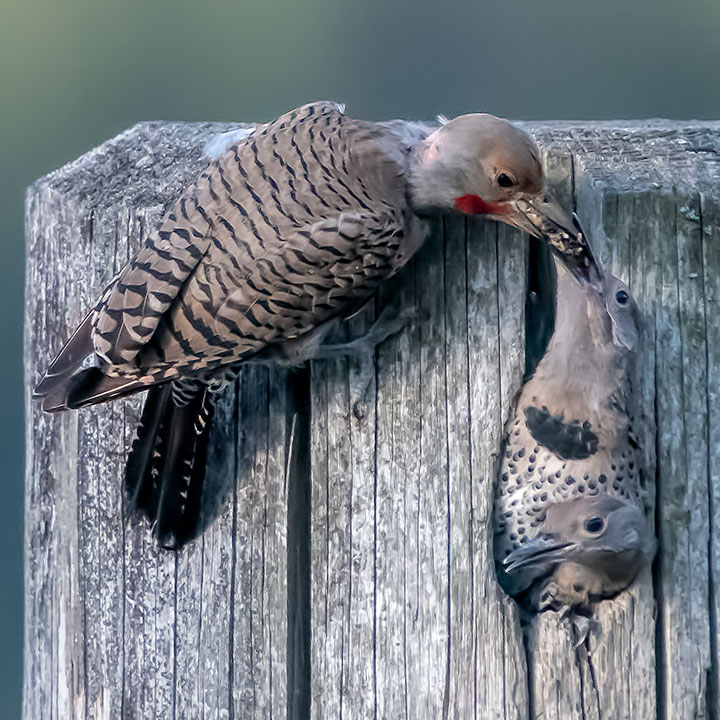
While a few other birds use flicker cavities, the dominant one seems to be the Tree Swallow. Here a father is bringing food to his chicks, each of which has its mouth open to accept it. However, since the Tree Swallow also regularly breeds elsewhere, a loss of wooden pilings is not expected to bother it significantly.
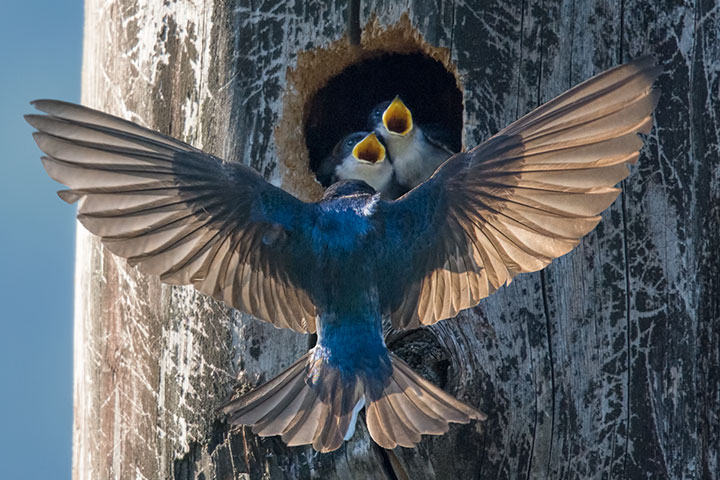
Ospreys are now the dominant breeder on wooden pilings. At earlier times, they chose trees beside the lake, although ones that usually were not quite so precarious as the one shown in this 1887 illustration. In modern times I have only seen a few couples nest in a tree, but now they almost exclusively nest on wooden pilings, dolphins, or special lake-side poles erected for them.

My earliest knowledge of ospreys nesting on wooden pilings comes from Troup. I don’t know when these had been put in, but pictures reveal that they were not there in the mid-1890s and were in place in 1929. In the mid-1940s, I summered right across the lake from Troup and I recall my uncle talking (in dismay) about someone setting the pilings on fire so as to kill the birds nesting on them. Apparently the arsonist’s logic was that the ospreys caught and ate fish, and, not liking the competition, he wanted to catch those fish for himself. Apart from the cruelty involved, his logic was flawed in that ospreys do not generally catch the same fish as those preferred by people. These pilings still show the signs of having been burnt (photo from 2005). However, it is clear that, by the 1940s, ospreys were building nests on the fairly newly established pilings.
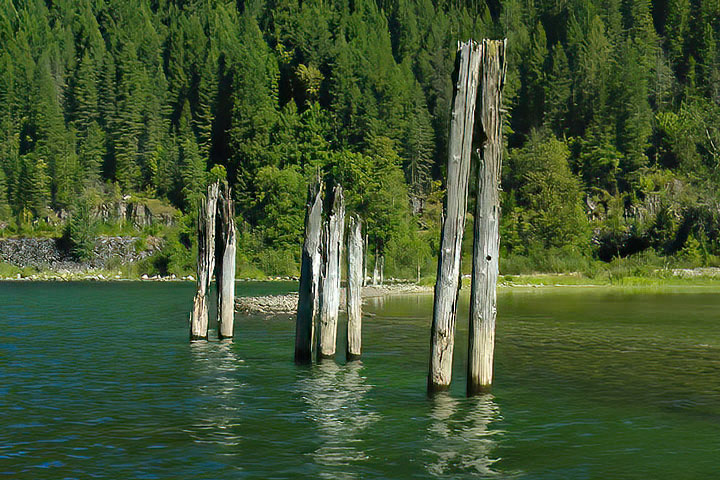
I don’t know when Ospreys began to build nests on dolphins (as distinct fr0m on isolated pilings), but it was probably in the 1960s. In the early 1970s, the number of Ospreys around Kootenay Lake began to increase, and many of these magnificent birds chose the dolphins as a nesting site. Now, an Osprey nest is a rather substantial structure, and when built at the top of a dolphin, it engulfed the light rendering it useless. Although at first the government would remove the nest to reveal the light, they soon changed tactics. They accepted a suggestion by Bob Denison that platforms be added above the light. Since his summer cottage was at Atbara (at the Nine-mile narrows), the dolphin there was the first to have this addition (which he put up himself). These platforms now characterize all dolphins and most play host to Osprey nests and Ospreys. This is the platform on the top of the Nine-mile dolphin at Atbara. Indeed, this practice of building a nesting place for the osprey has gone further than dolphins now. The power company and also private individuals have erected nesting platforms on poles placed near the lake which the ospreys have used.
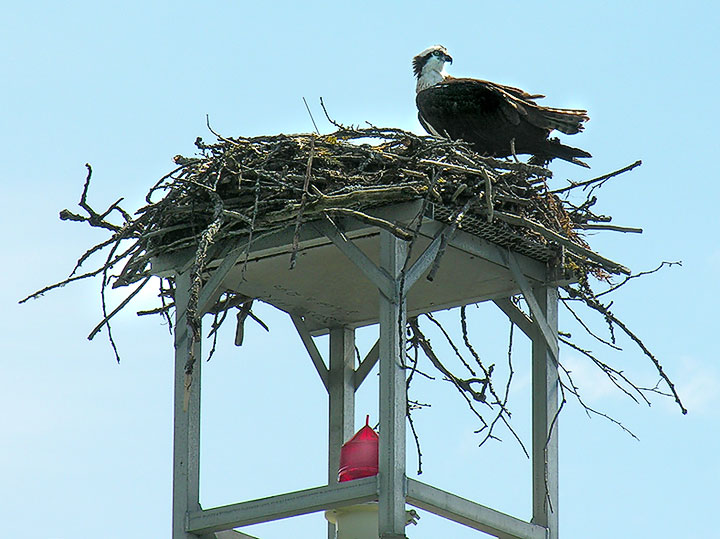
While I found I do not have a satisfactory shot of a constructed nest platform installed solely for the osprey, I do have a shot of two (full sized) chicks that had just flown from one while their parent watched from above. We can tell these are chicks because of their orangish eyes and their white-flecked wings.
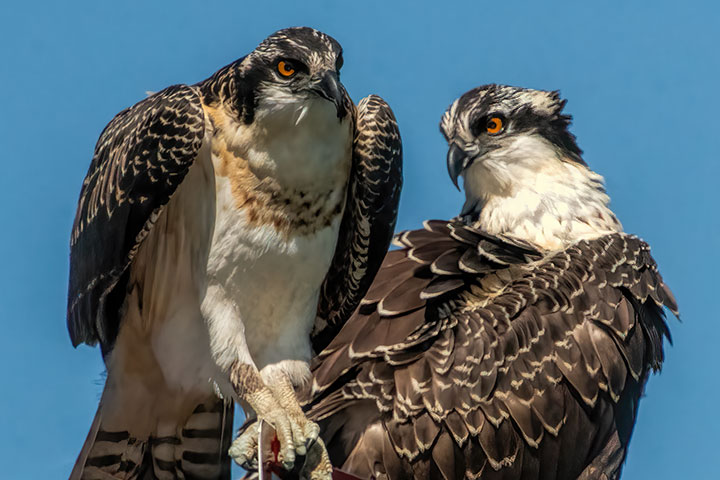
The osprey’s preference for nests on or beside the lake is driven by its food: it catches fish. 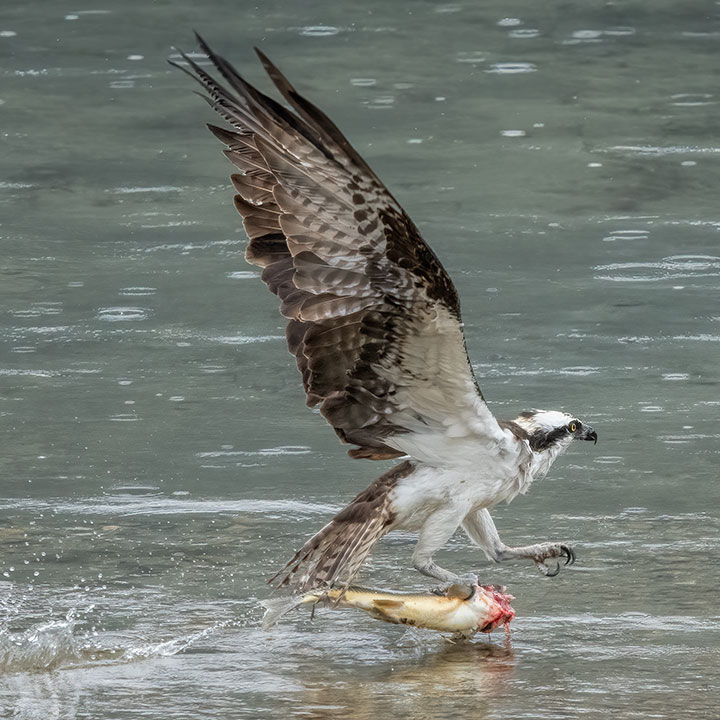
This view of a nest on a wooden piling is of the father osprey bringing a fish to his family. There are three chicks (white spotted wings) and his partner (plain brown wings). When the wooden pilings vanish, the osprey will be likely be fine; it will still have trees and erected platforms on pilings and the dolphins, all in or close to the water.

An advantage of the wooden pilings is that they are out in the water and so free from land predators. This, of course, changes when Kootenay Lake water levels are low during the spring, but then that is not the nesting period. I have assumed that the main land predators of concern would be raccoons. But the squirrel is the only land predator I have thus far seen attacking a nest cavity. In fact, wooden pilings have been a particularly safe place for a nest cavity. Metal pilings will certainly bring advantages to people, but the safe perch and nest will be lost.

As a digression, I note that I have not covered all of the nesters to be found on a wooden piling. There are others. Consider this deer fly laying eggs on a piling. Deer flies were seen laying near the same spot on two separate years. 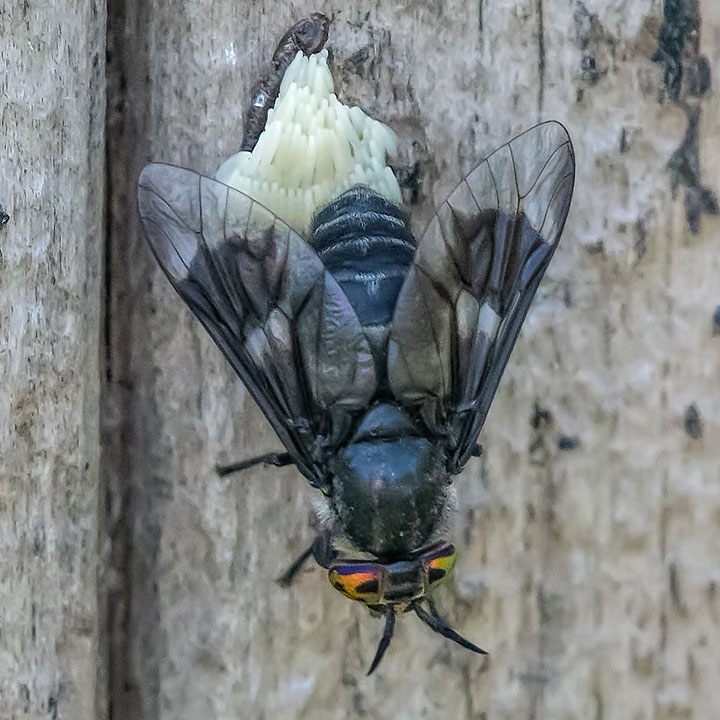
The eventual loss of the wooden pilings will be a disappointment for the ardent nature observer, but the animals will adjust. Probably the greatest loser will be the Northern Flicker who found a largely predator-free place to nest. So here is another shot, this one of the mother feeding its two chicks.
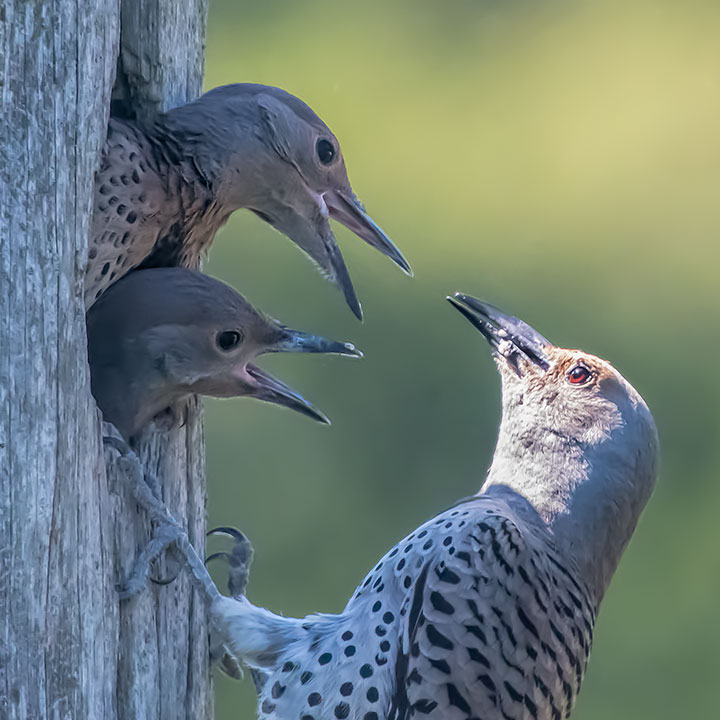
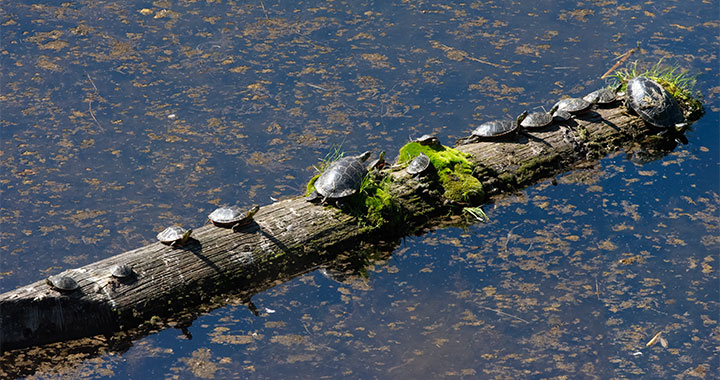



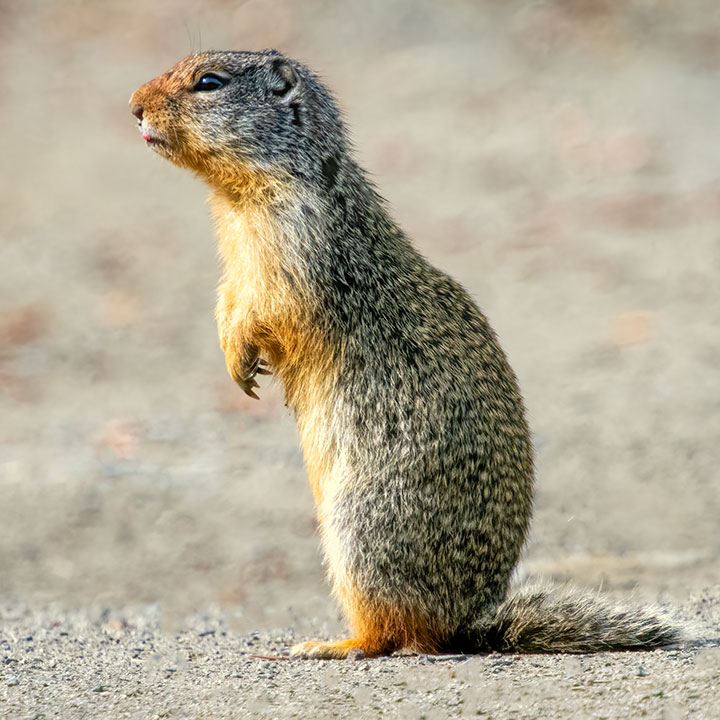


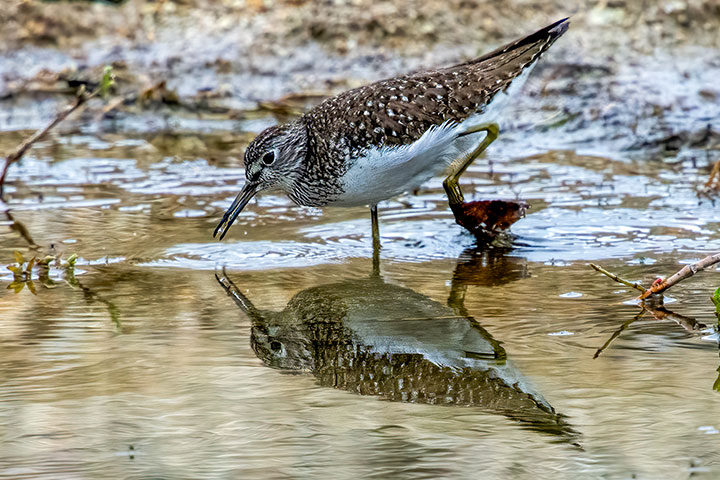

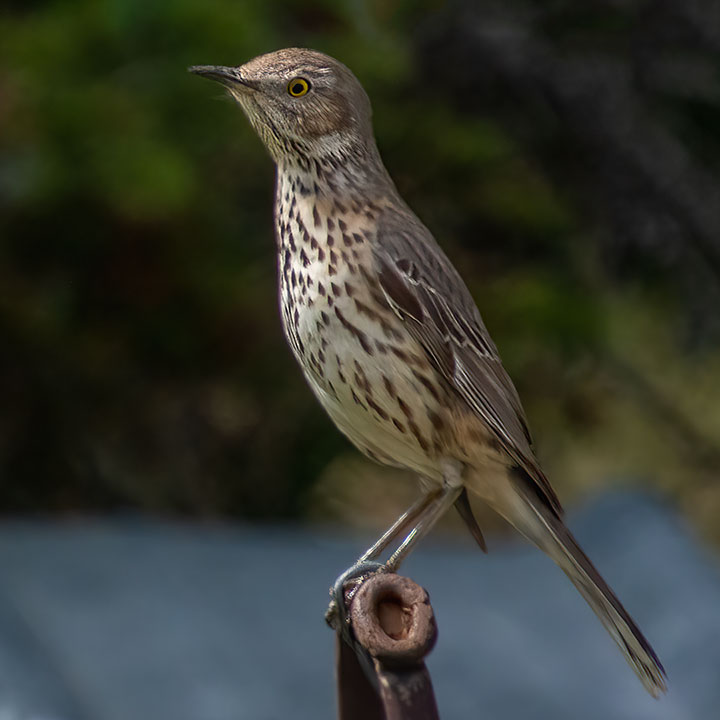
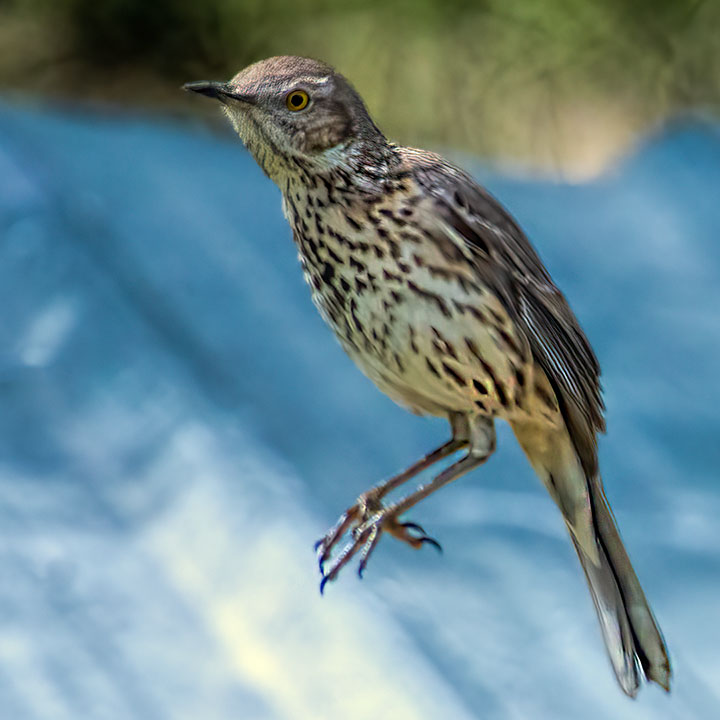
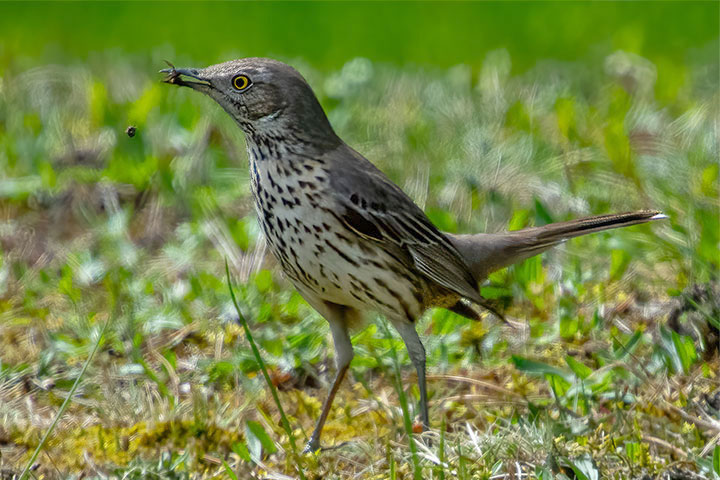
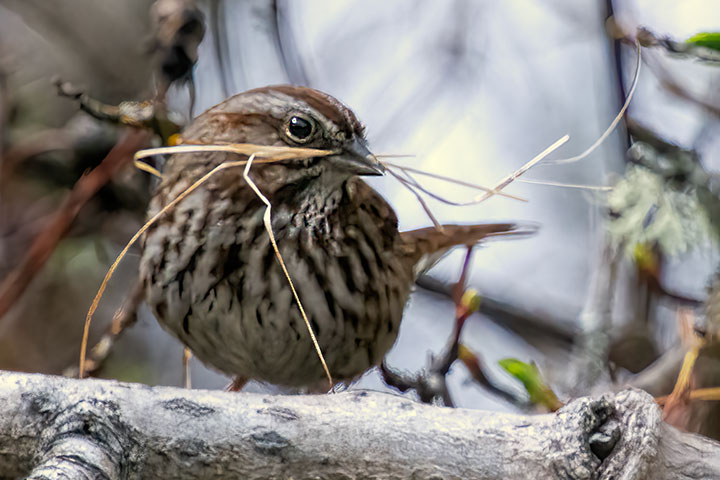
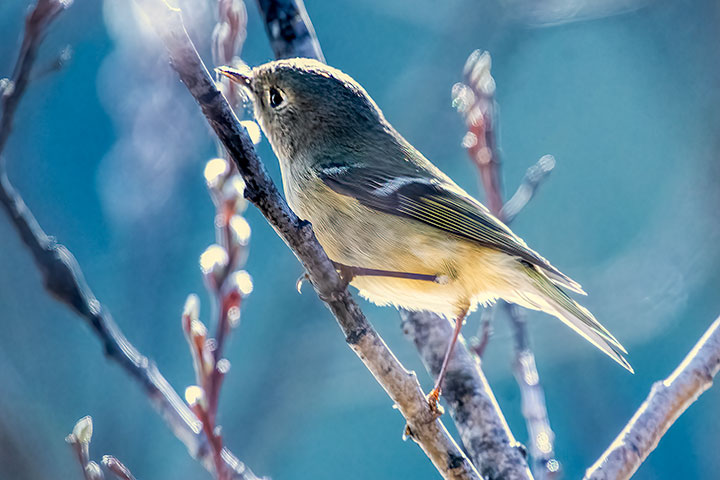
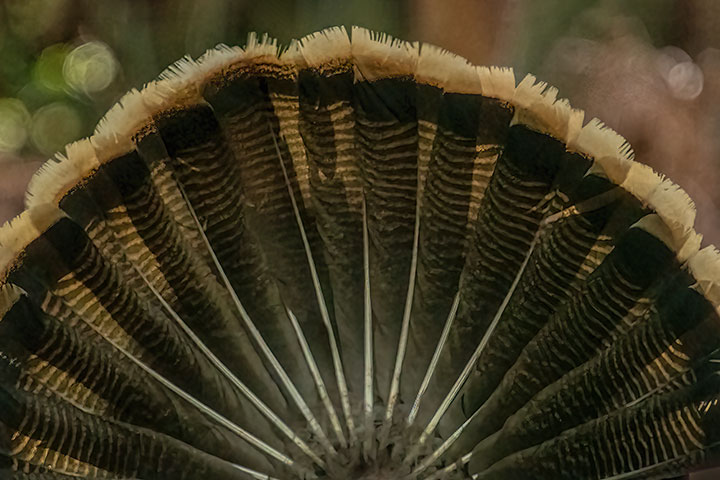

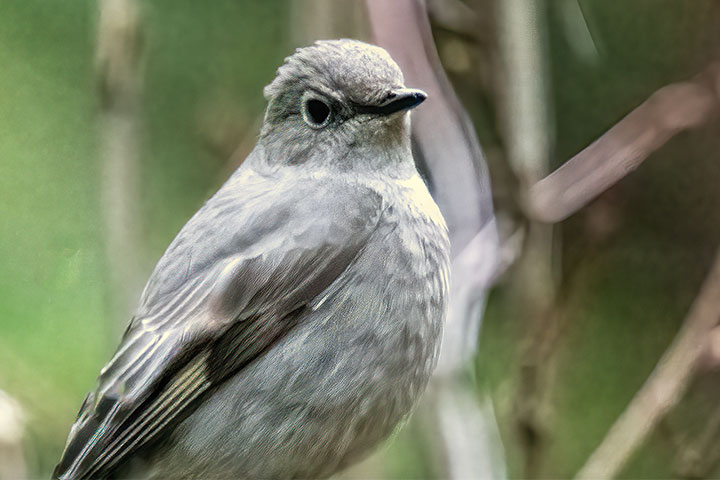
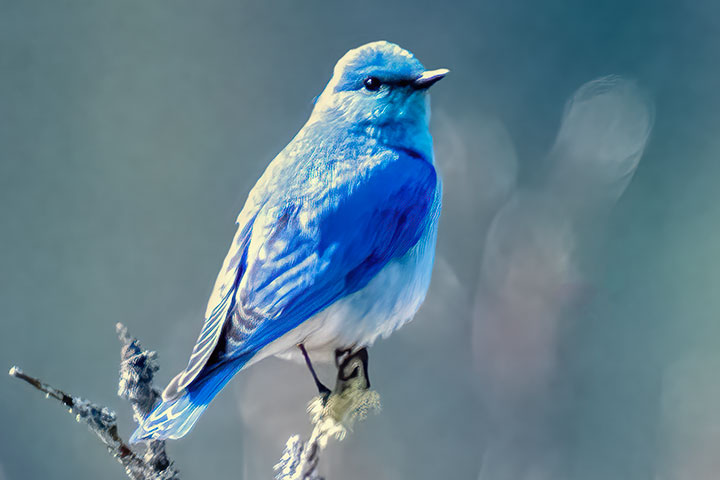
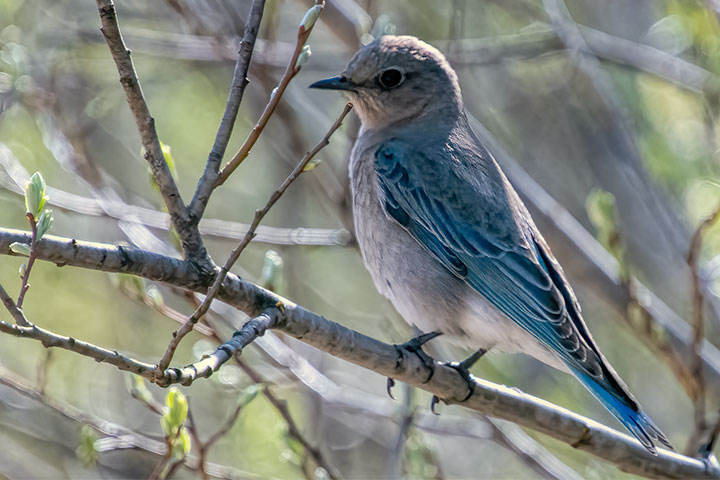
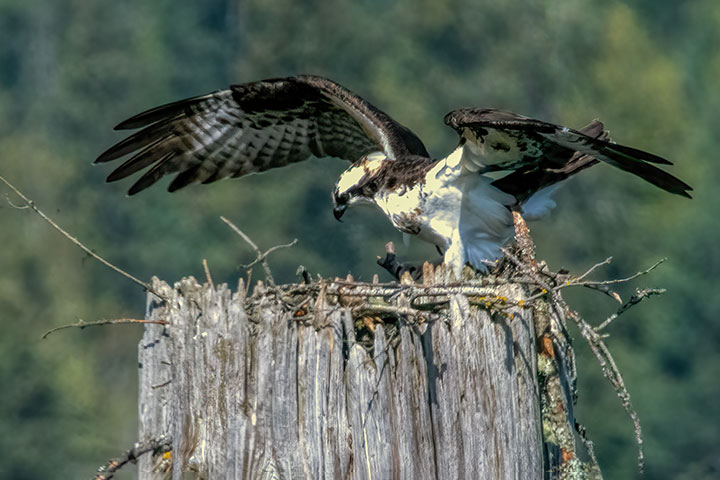
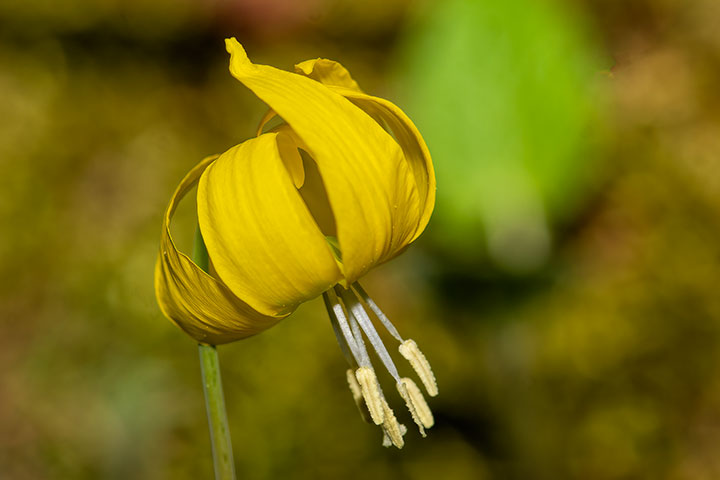
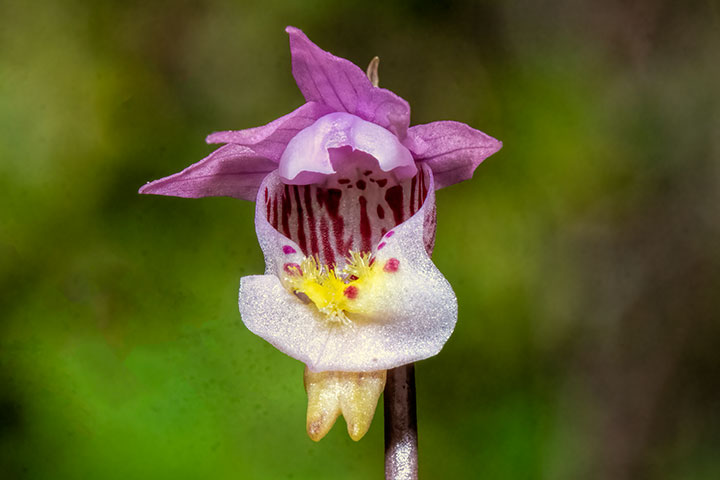
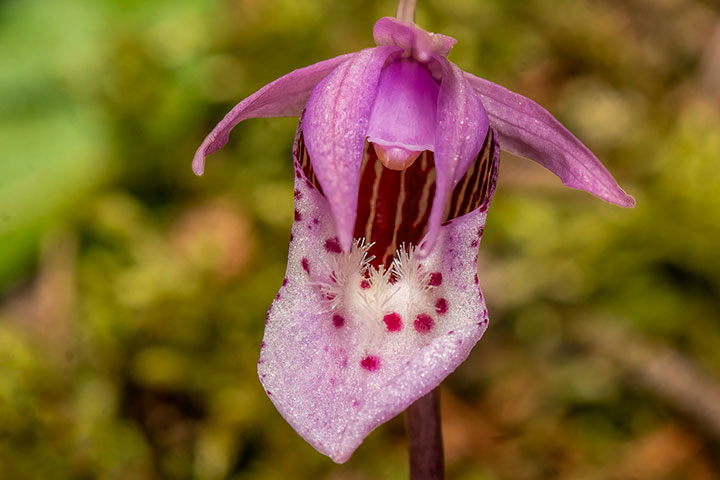
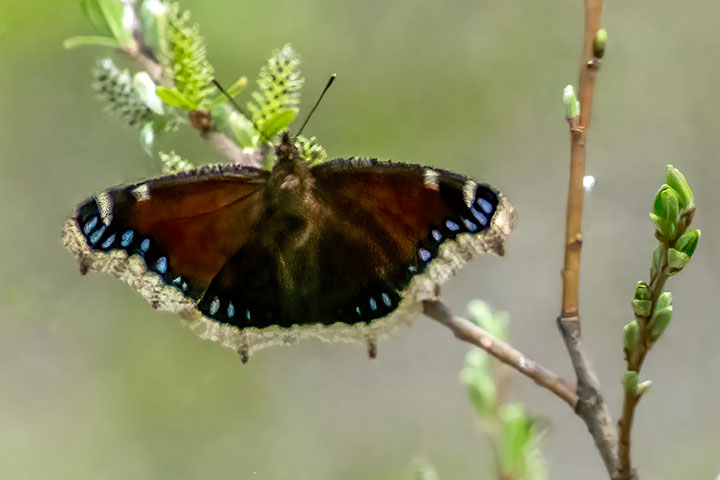
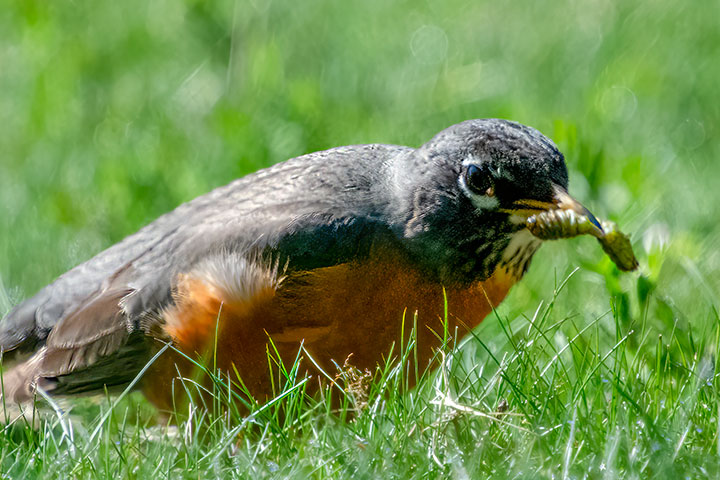
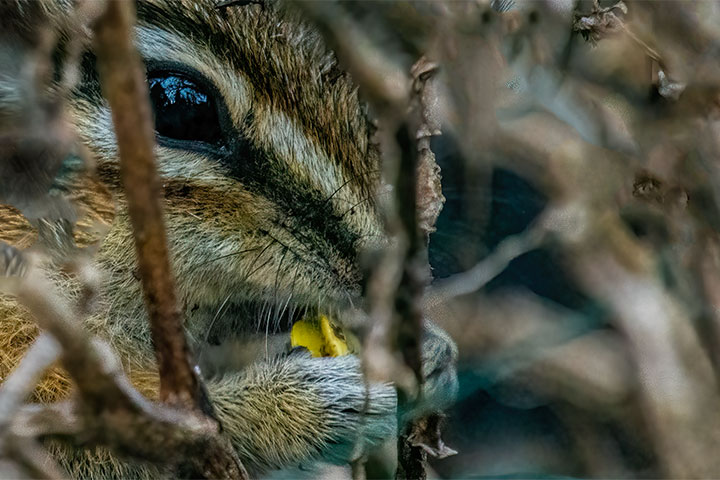
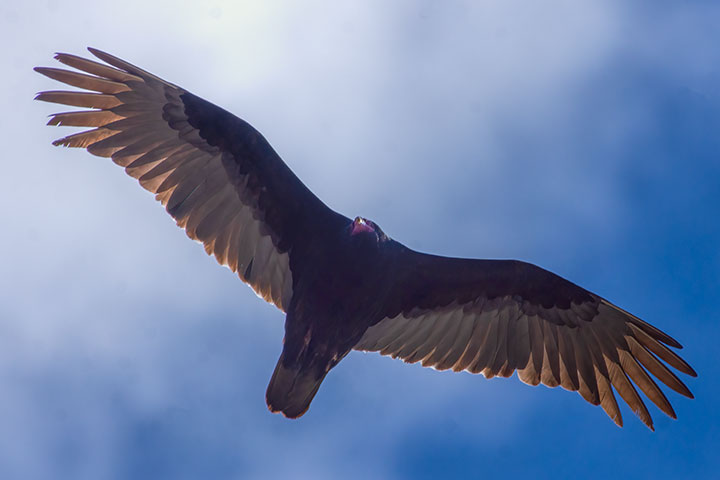
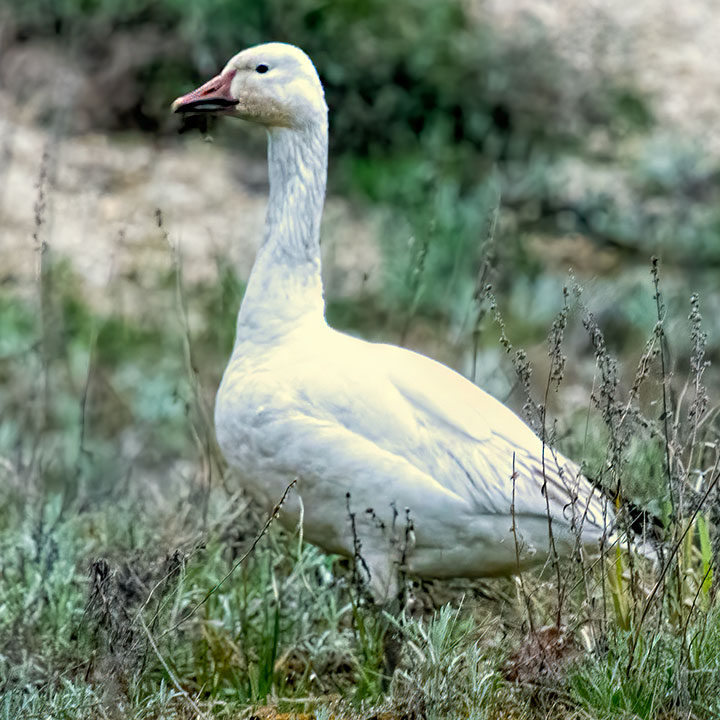
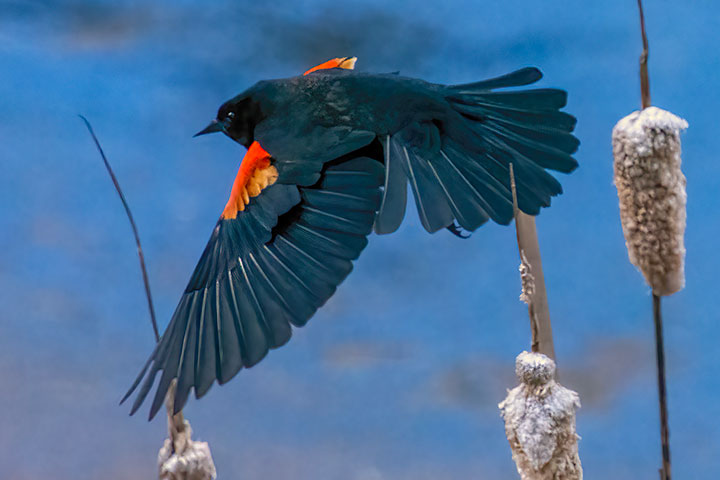
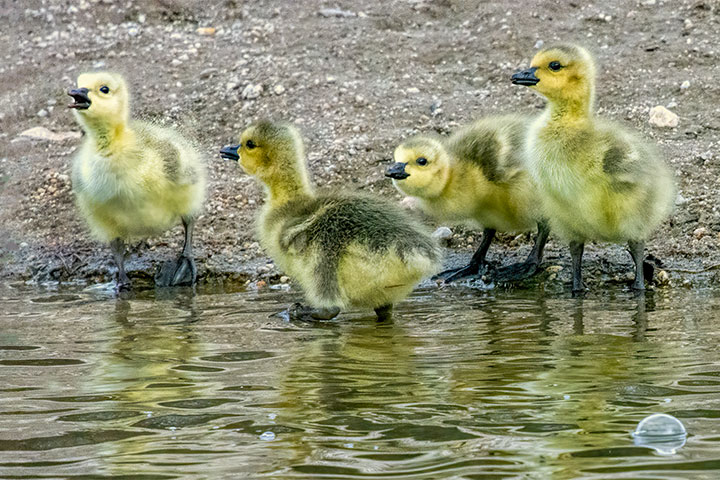
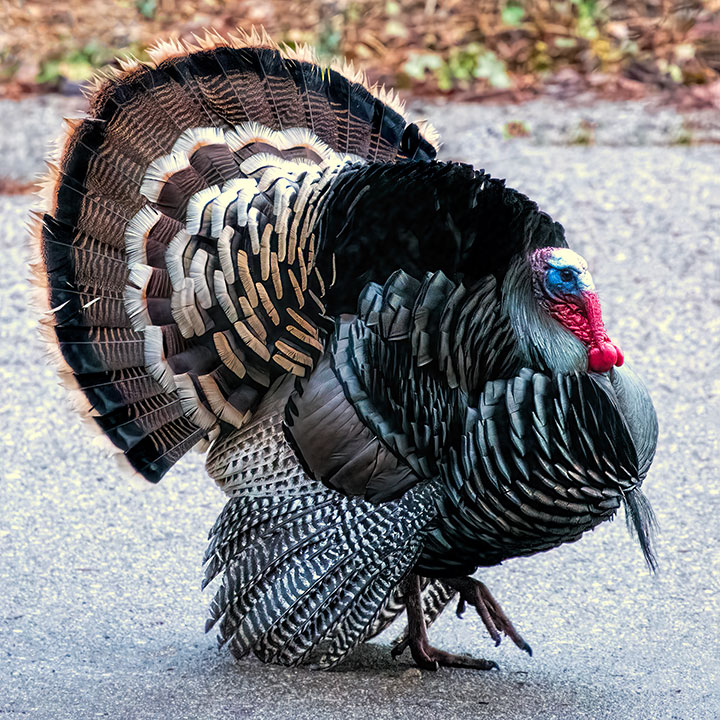

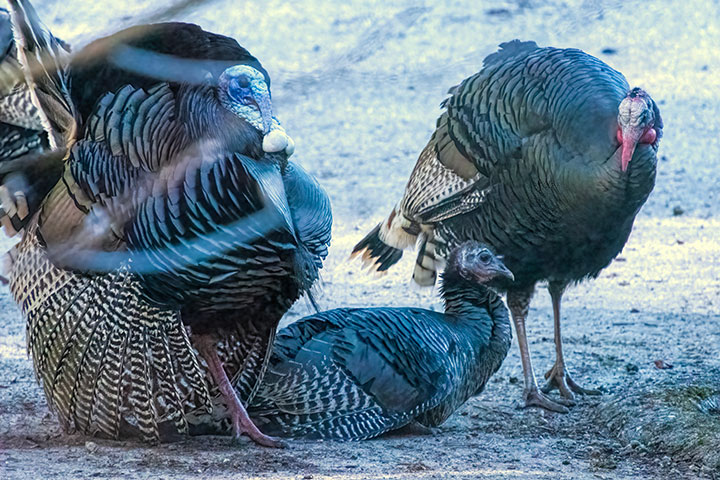
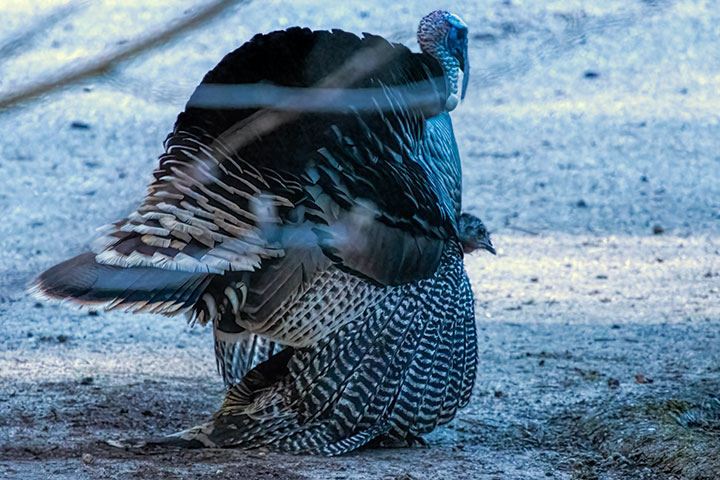
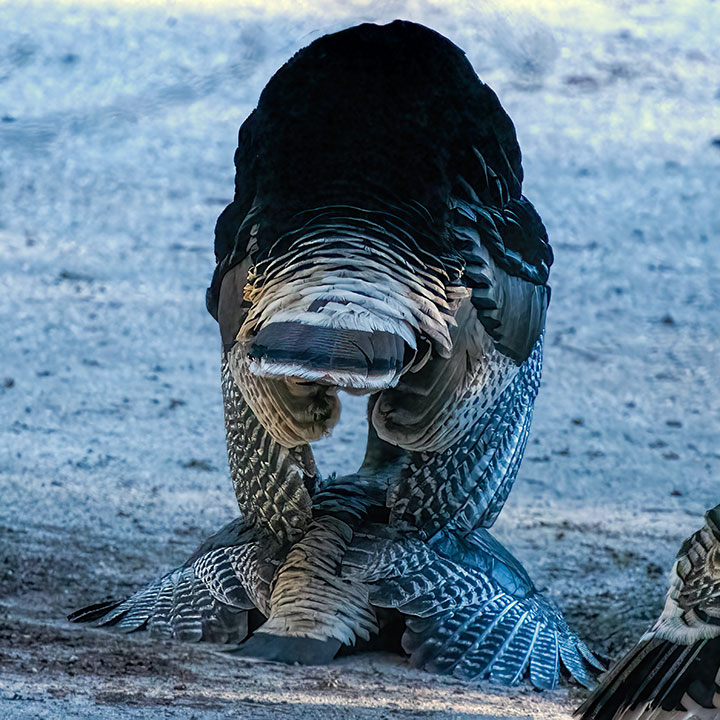
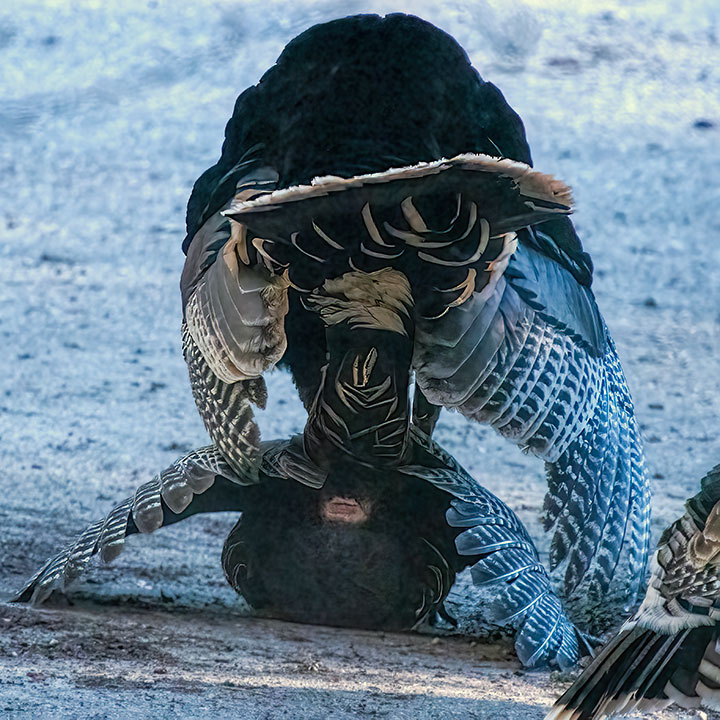
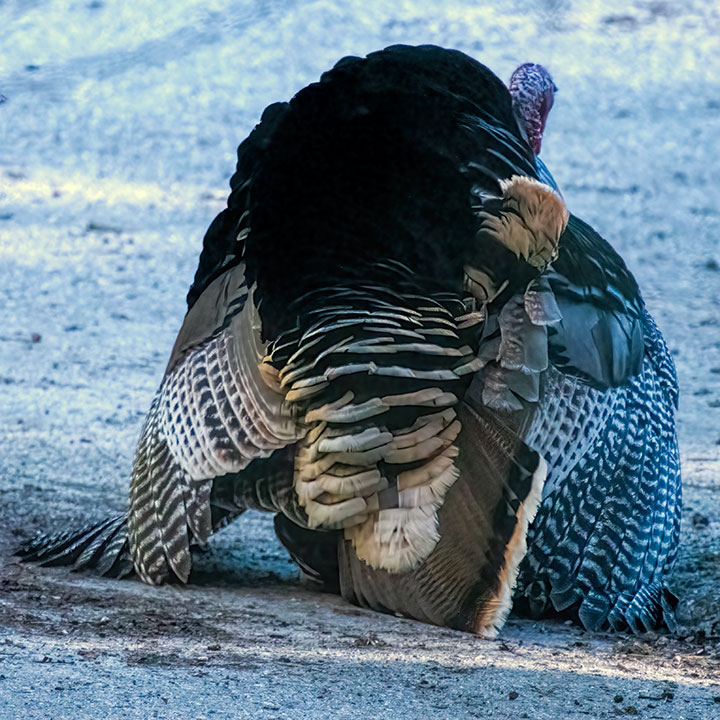
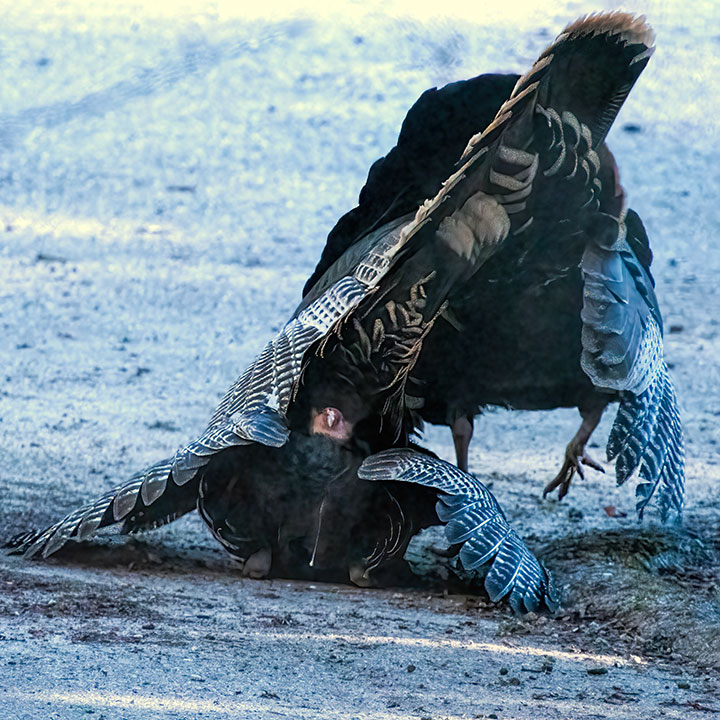
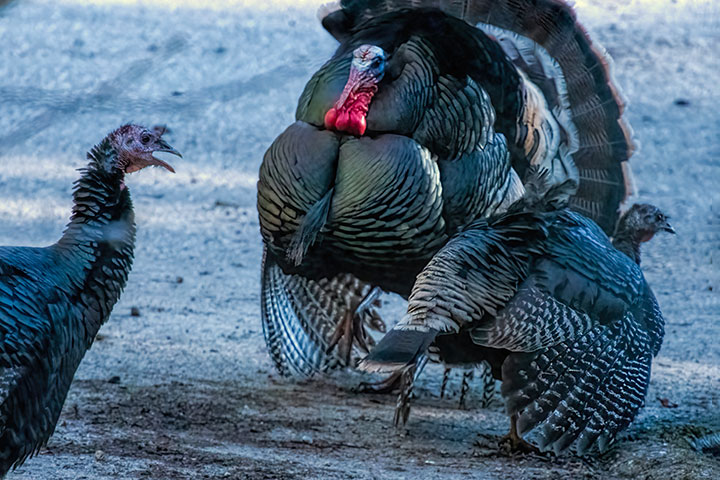











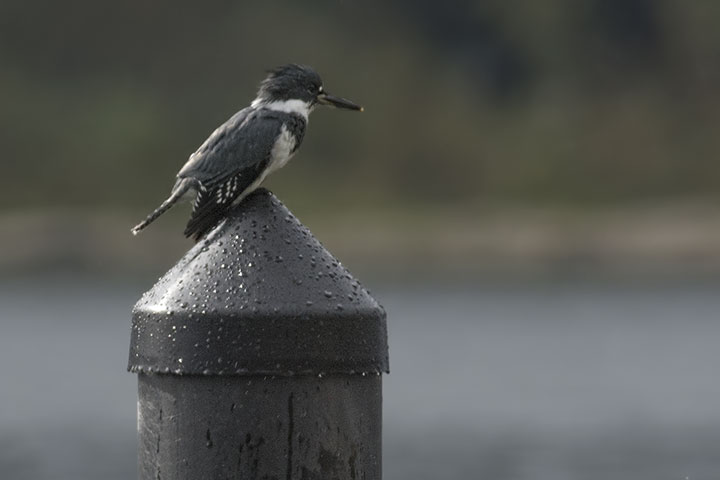
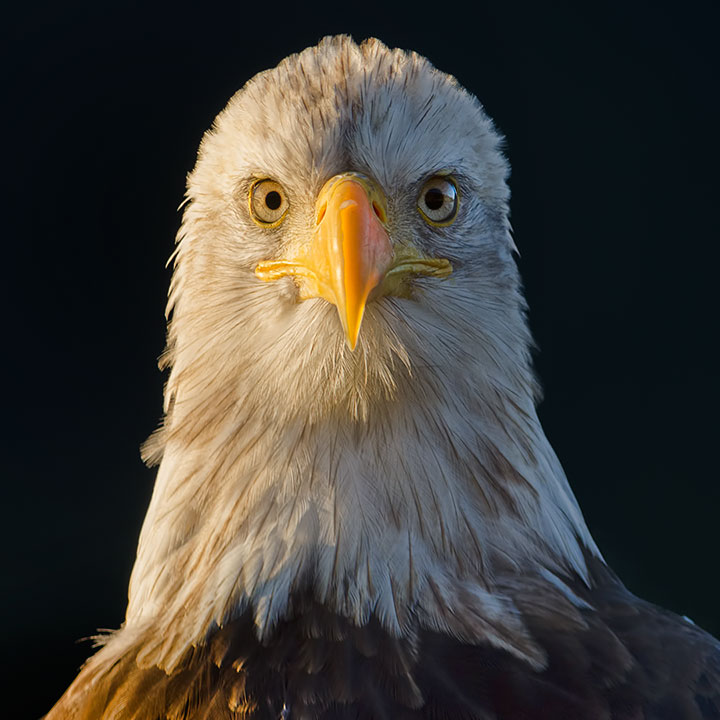
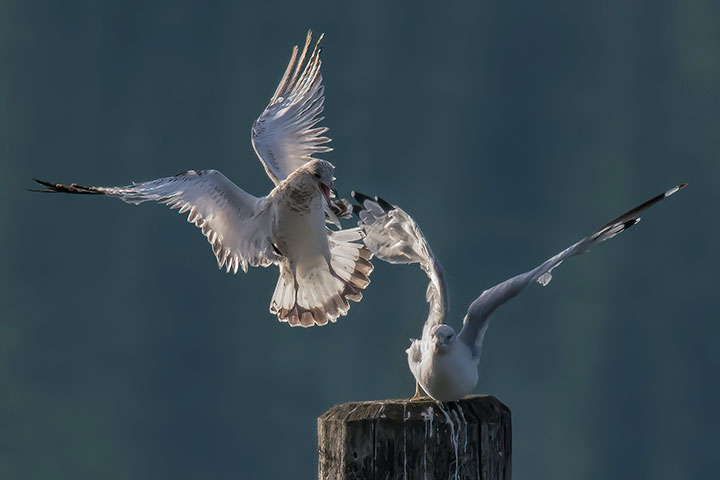

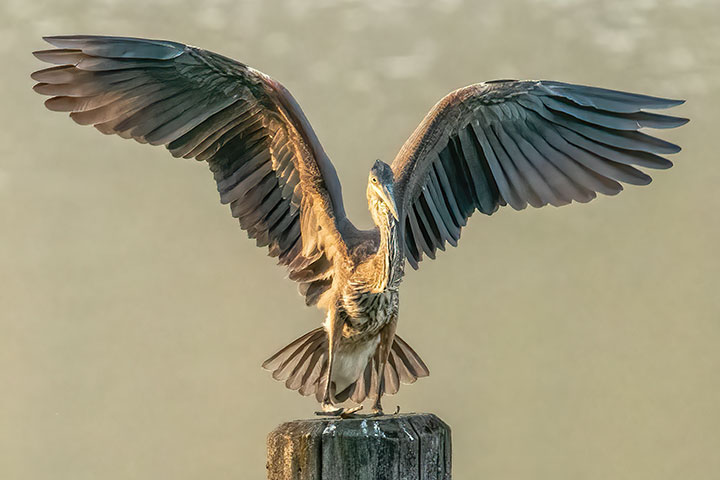
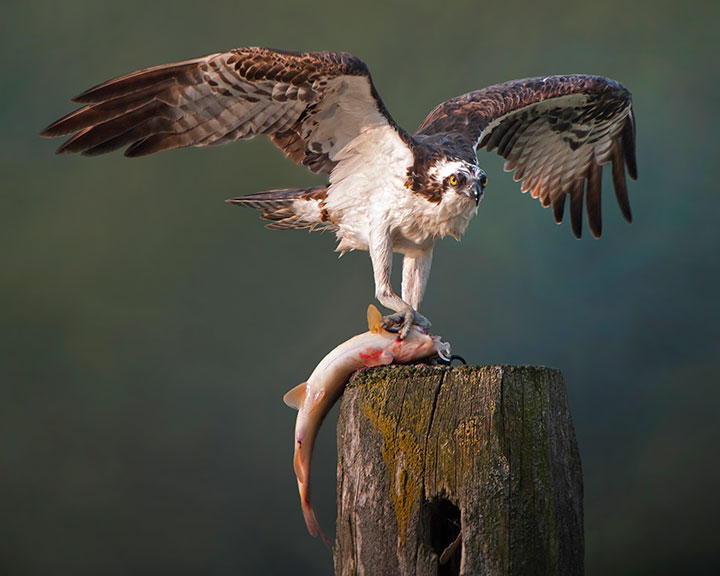
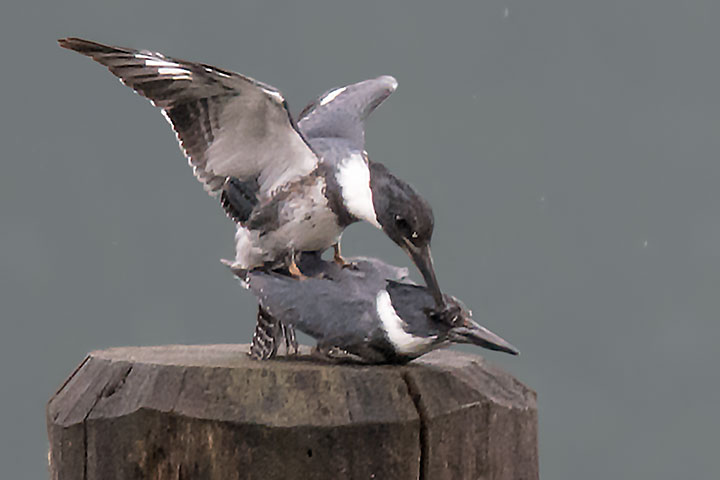
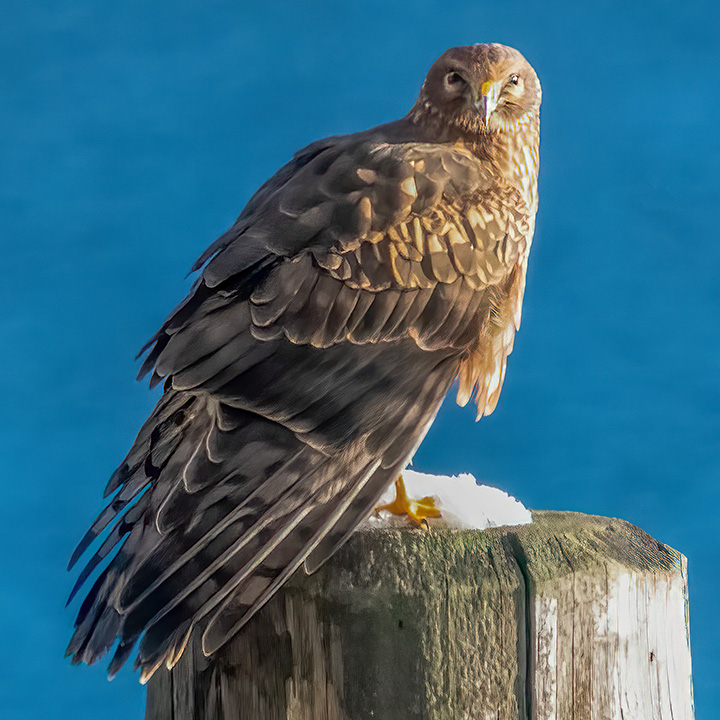
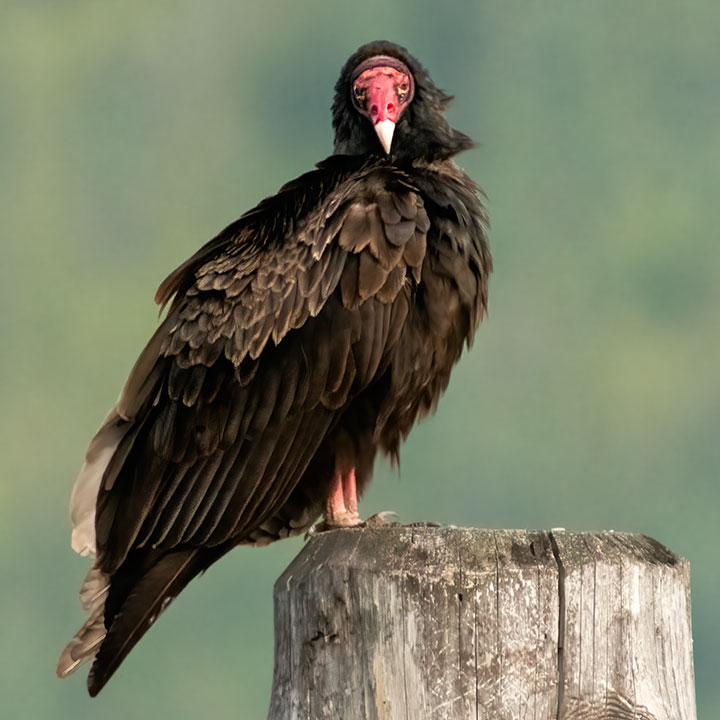
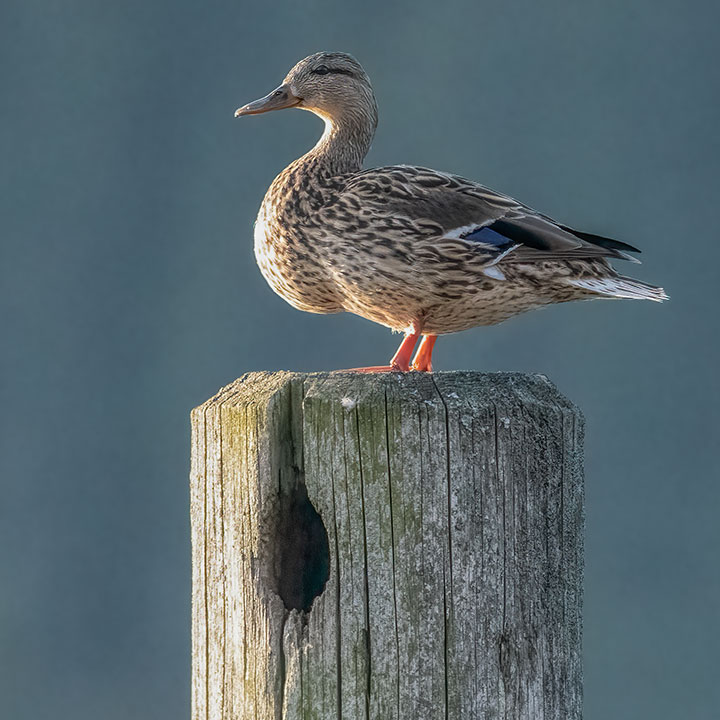
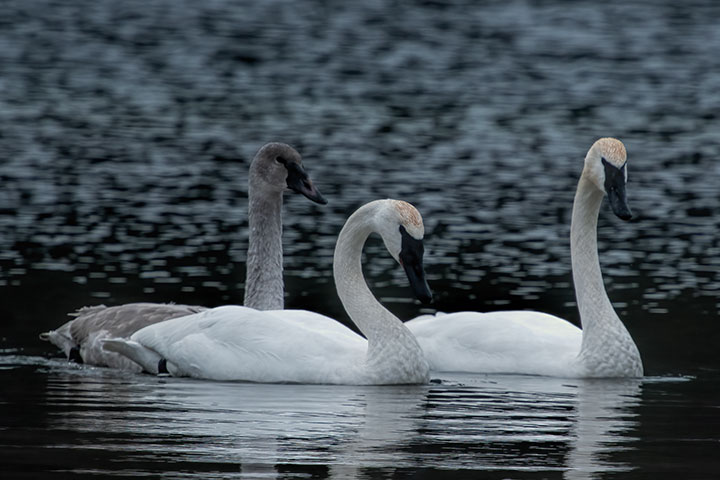

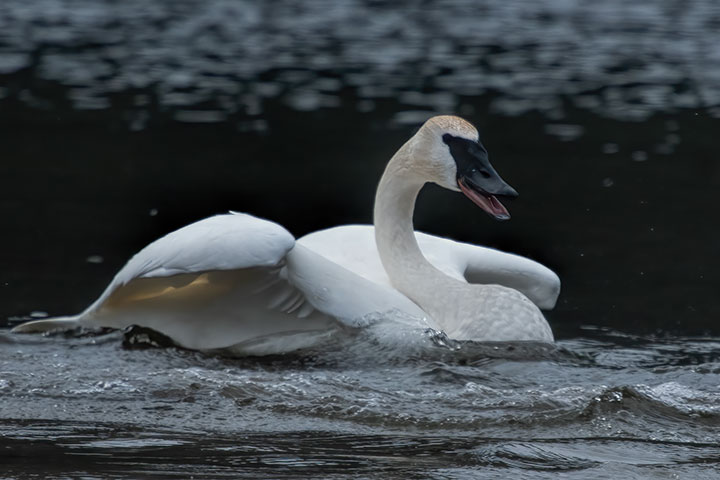


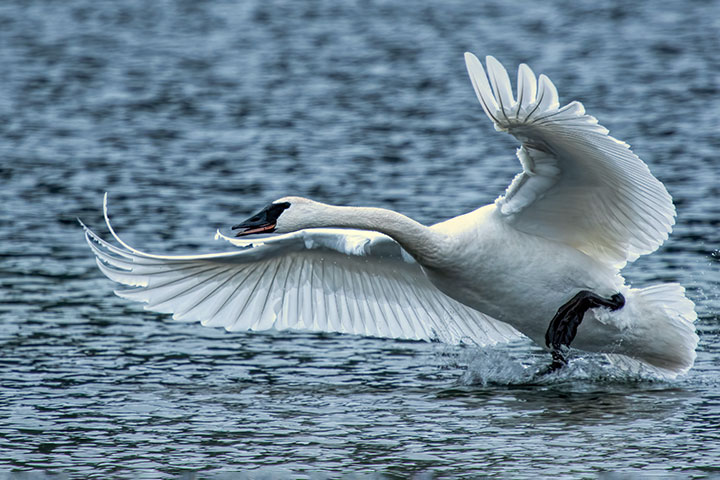
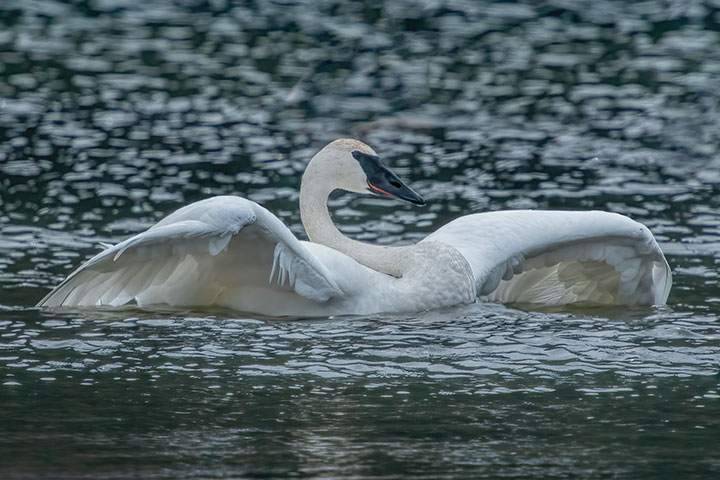
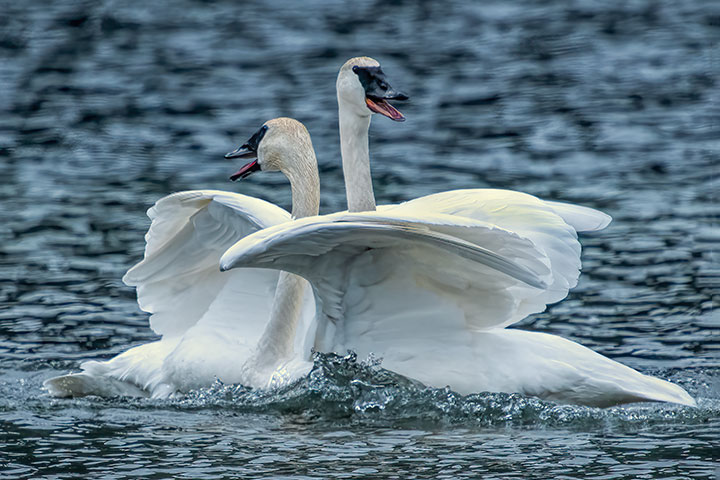
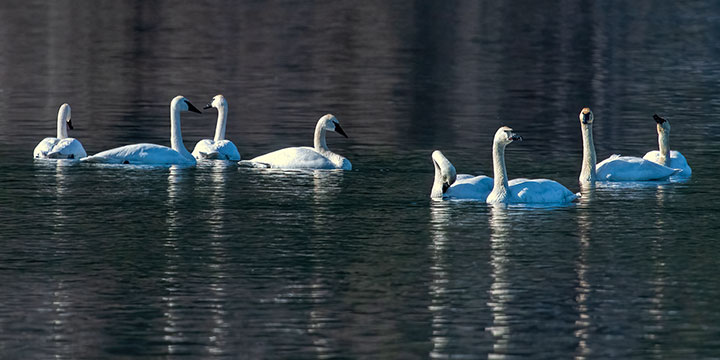
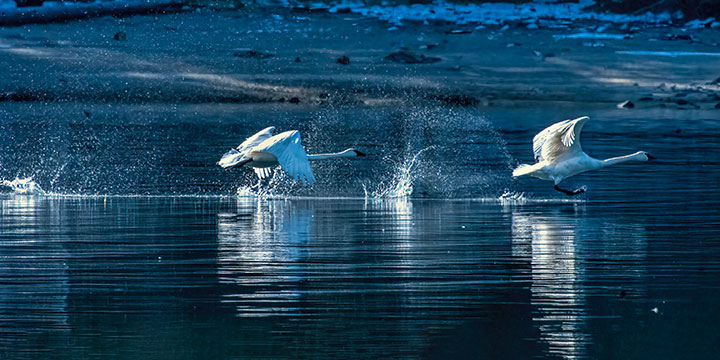
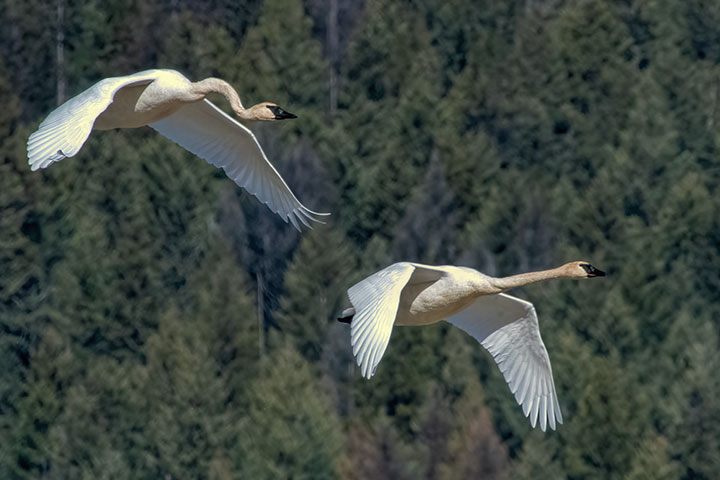
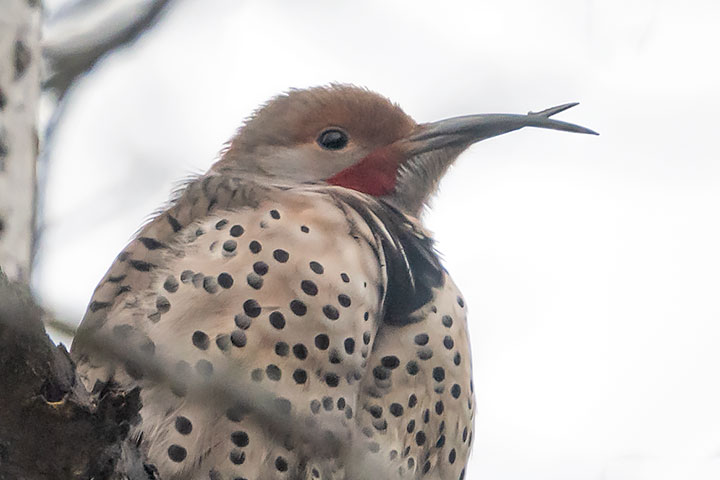
Eagle’s lost nest
Thursday evening (May 16, 2024) a Bald Eagle’s huge nest came down when the top part of the tree blew off in high wind. The two chicks in the nest were killed in the fall to the ground far below as they were just sprouting feathers and still unable to fly. Their two parents survived because they could fly.
The nest was at Fraser’s Landing beside Cherry Bay on the west arm of Kootenay Lake. The nest had been a favourite of mine for a few years. Each year, I photographed the parents and chicks and watched the nest grow larger and larger. What the surviving parents do now is yet to be seen, but they may try to make another nest nearby.
A discussion of the problem faced by eagle parents follows shots from the last few days.
Less than two weeks before the wind, I had taken this shot of the mother on the nest. The two chicks are still too small to be seen above the brim of the nest, but what is evident is that the nest itself is gargantuan.

This was taken a day and a half after the top of the tree and the nest came down in the strong wind. The top of the tree and the debris of the nest is on the ground. The remaining lower part of the tree is standing on the right,
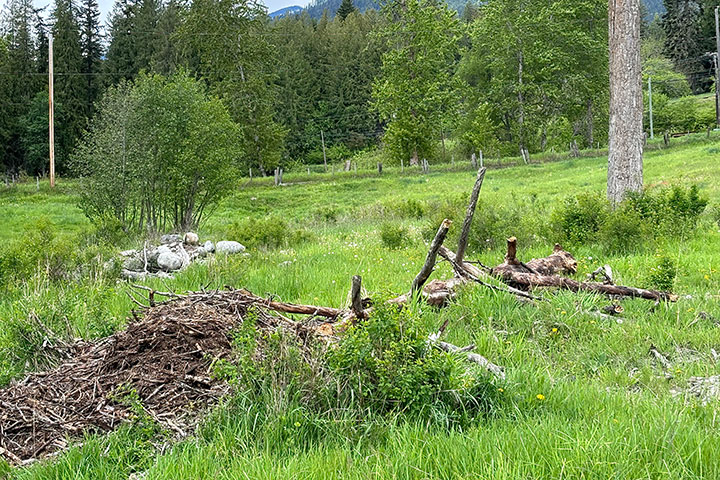
A day and a half after the wind, the two parents are in an adjacent tree. The male (right) has just flown in with a fish. They must now decided what to do. Photo by Cynthia Fraser.

Now, some reflections on the situation. Eagles like to find a tall largely bare tree (this one was dead) near the water. They started the nest maybe a half-dozen years ago. Each year they added to it, until it was big and heavy enough to bring down the tree in a strong wind. The question is: why was the nest allowed to become so big and heavy that it collapsed the tree and killed their chicks?
The simple answer seems to be parasites. Bald Eagles are at the top of their food chain and there are few other animals that catch them and eat them. But parasites are very small and are found on the tree and in their food. It seems that protecting themselves and their chicks from parasites prompts them to add a new fresh clean layer atop the nest each year. So, the nest gets bigger and bigger and this ultimately almost always causes it to fall in a strong wind. So, their tactic of adding sanitized layers makes sense. Unfortunately, they wait until the nest makes the tree fall rather that quitting after, say four or five years, and at that time building a replacement nest.
To celebrate this tree, here are two pictures from the past.
Both parents and two small chicks in the nest from 2022.
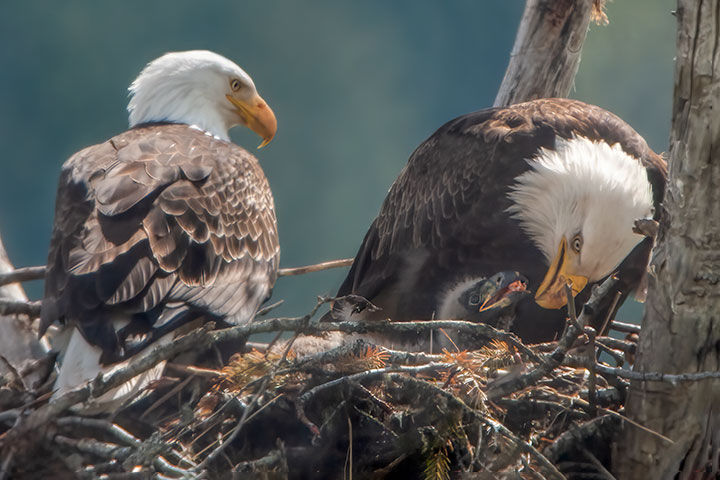
One parent and two larger chicks in the nest from 2021.

This is not the only eagle nest I have watched come and go. But, I want to mention one other dead tree that was visited regularly by Turkey Vultures until it fell down. Alas, as far as I know, it hasn’t been replaced.
For some time, a tree near Red Fish Creek was used by Turkey Vultures to warm their wings in the sunlight. But, these birds did nothing to bring the tree down; it just fell when there was no wind.
